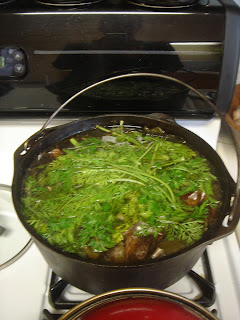
more on the subject of Wasting Nothing ~ we've been making a lot of broths lately.
as we are preparing the evening meal, we collect all the useful scraps in a bowl ~ onion and garlic peels and nubs (there's a whole lot of those), leek parts, carrot nubs, green tops ~ such as carrots and leeks, ginger, peppers, celery and its leaves, herbs, and bones. we keep a few gallon-size freezer bags in the freezer, and just deposit the scraps in the bags.
when one of the bags is full, it's time to make broth.
we have a cast iron Dutch Oven (a soup pot with a tight-fitting lid) that i fill with scraps.
i usually include an extra onion, or any loose garlic cloves lying around,
and a few sticks of kombu seaweed~ extra dense with minerals.
depending on the flavor i'm after, i might add a sweet potato or carrots for sweetness, or extra ginger, or hot pepper, or even more garlic. you can tailor your recipe, with herbs and spices, too, or enjoy the pot-luck.
i fill the pot with filtered water so that it covers the scraps.
slowly bring it up to a boil, then turn it down to a simmer.
with an all-veggie broth, you can let it simmer for just a few hours till the veggies are soft, or you can let it long-simmer to get a dense, mineral-rich broth.
the kind of bones you include dictates how long they simmer. fish bones ~ heads and all if you have it ~ take just an hour or so, not longer.
chicken and beef bones are very nourishing. to get all the goodness out of these, keep the pot on a very low heat for up to two days.
add a couple tablespoons of vinegar to pull the nutrients out.
check the pot occasionally and add more water so that the ingredients are always covered with water.
when the broth is done to your liking, strain it. then: use it, or
let it cool ~ you can set the pot in a larger container with ice, or pour the strained broth into a shallow dish like a casserole and set it on ice (veggie broth needn't cool with as great haste).
transfer the broth to smaller containers. i like to pour it into glass jars, and set them (tightly sealed) on their side in the freezer for quicker thawing. lots of people like to use ziploc bags, and freeze them flat; this works well too.
label them so you remember what they are.
(things not to be included in the broth-pot: high-fat fish bones, such as salmon [the oil breaks down too quickly, and then is not good for you], and members of the cabbage family [these tend to add too strong a flavor]).
anytime i make a soup or sauce, i pull out some broth and use it for the liquid.
this adds so (!) much flavor (!), and so (!) much nourishment (!) to the meal.
if you eat meat, the gelatin in the broth helps your body assimilate the nutrients.
~ and any "real" cook (says _The_Joy_of_Cooking_) swares by broths and stocks in her soups and sauces!
you can also use the broth by itself ~ for a nourishing meal on its own. . with a little salt, you're good to go! . . and ~ a great supplement for furry companions.
in Nature, there is no waste. broth-making is gleaning more valuables before they end up in the landfill.
plus ~ why throw away all that nutrient-rich goodness? responsible for you, your loved-ones, and the Earth.
broth making is so easy. it's takes a little forethought until you're used to it, but the rewards will train your brain very quickly! :-D


No comments:
Post a Comment